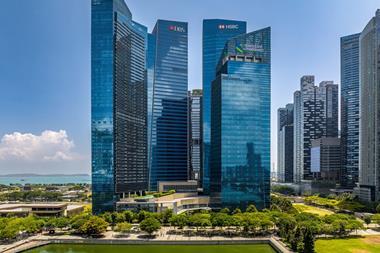Large pension assets and a small home market mean that pension funds from the Netherlands are ahead of their European counterparts whose Asia strategies are still relatively new. Kristen Paech reports
The globalisation of real estate portfolios by European pension funds has reached the sunny shores of Sydney where the office and retail markets are booming.
With office take-up reaching historical heights in many of Australia's capital cities, vacancy rates have been pushed ever lower, driving rental growth skywards.
Over the six months to January 2007, the total market vacancy rate in the Sydney CBD fell to 7.9%, down from 9.7% at the same time last year, according to CB Richard Ellis. The prime vacancy rate dropped even lower, reaching 5.6% in January, down from 9% a year earlier.
Add to these figures good transparency, high corporate governance standards and an impressive overall level of sophistication in the market and it is no wonder that the land down under has begun creeping into European property portfolios.
The most established foreign institutional investors in the Australian real estate market are arguably the Dutch, who have been investing in listed securities for some time.
The €216bn ABP invests through both real estate investment trusts (REITs) and listed property trusts (LPTs), as well as funds, while Mn Services, the pensions provider and asset management firm, invests through the GPR 250 Property Securities Index, with a 28% allocation to Australia.
However, more recently the Dutch have turned their attention to the unlisted sector, where Australia provides both core and value added opportunities.
"Especially during the last one and a half years we have strongly increased our exposure to the Australian non-listed real estate markets in core strategies, both in office and retail," says Patrick Kanters, managing director real estate, Europe and Asia/Pacific, at ABP. "The last 12 to 18 months were a very interesting time to re-enter the office market, given the favourable outlook for most office markets in Australia with vacancy rates declining and rental growth coming back again. We have also increased our allocation to hotel investments in Australia, based on a very healthy outlook and strong managers that are providing us with good products."
While Sydney is driving a large portion of the market's growth, industry pundits say interest is not yet geographic-specific.
"You don't get Sydney-specific funds, but ultimately the funds tend to be heavily weighted to Sydney by virtue of the fact that Sydney is the largest economy," says Brett Robson, global head of real estate private placement at Macquarie Bank in Sydney."Investors are clearly interested in what the underlying geographic diversification is, but they're not focusing on Sydney per se."
Mn Services, which has metal pension funds PME and PMT as its main clients, is considering investments in the unlisted sector.
Carolijn ter Haar, fund manager, international real estate, views the restrictions on the retail sector, where the planning environment preserves the right of major shopping centres to grow and dominate their catchments, as a potential opportunity.
"We are also looking at the office sectors which are doing well at the moment because of the booming economy and especially Sydney, which has some restrictions because of the natural borders like the mountains and the harbour," she says. "There might be some redevelopment opportunities there as well."
PGGM is another active investor in the Australian market. Earlier this year, the fund closed a €660m deal in property linked notes with Australia-based real estate firm Westfield Group.
But despite strong interest from the Dutch, their continental counterparts have been slow to follow suit. At this stage, only those with a dedicated Asia/Pacific strategy have begun seeking exposure to Australia. And even then, it is at the discretion of their fund managers.
Finland's Ilmarinen Mutual Pension Insurance Company has US$40m (€28m) invested in Asia/Pacific real estate through funds of funds, which are focusing more on Asia.
"Given the maturity of the Australian property market coupled with high interest rates and low yields we would prefer (due to the FoF approach this is not totally in our control) alternative sectors which can offer higher yields," says Mikko Räsänen, portfolio manager at Ilmarinen.
"These traditional sectors, for example retail and office, which are heavily dominated and aggressively priced by local LPTs, can be at risk of adverse yield movements. The rental performance should be solid and stable across all sectors."
Stephen Hayes, managing director, Perennial Real Estate Investments in Sydney, says UK pension funds in particular have been insular with regards to real estate exposure.
"It's not a very large market so if European institutional investors want to invest large amounts of money it takes time and the opportunities are not always prevalent," he says.
"GIC (Government of Singapore) has been aggressive in the past and we have had some Asian investors buy real estate here, but recently the more aggressive buyers have been private equity."
Timo Tschammler, director international investments at DTZ, believes only two transactions from foreign institutional investors have taken place in Sydney itself, both by the UK's New Star. Alistair Meadows, divisional director, sales & investments, at DTZ, adds: "It seems a little early in the process to judge the mid- to long-term presence of European institutional pension money in Australia, because its focus on the Asia/Pacific region is rather recent and has been partly necessitated by a yield/return compression in other markets."
Indeed, there is little appetite in Sweden, with AP3 the only buffer fund currently looking to build an indirect international exposure, with the first commitments made this summer.
"AP3 is planning to make more commitments to international real estate investments during the second half of 2007," says Christina Hillesoy, the fund's spokesperson.
"We want to expand our real estate portfolio into three regions; namely: Asia (where we count Australia as part of that region), Europe and North America. However, it will take several years to build this portfolio."
Likewise in Denmark, not even the country's biggest fund, the €50bn ATP, has looked far beyond Europe.
"In our strategy we also have the possibility to commit money to the US market but Asia and Australia are not yet on our agenda," says Michael Nielsen, managing director of ATP Real Estate. "We may reconsider that position within the next two or three years."












